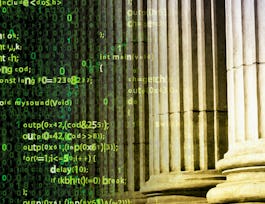This course dives deep into the world of Linux, beginning with an introduction to its structure and how to run it on different operating systems. From setting up a Linux container with Docker to understanding the command-line interface, learners quickly get comfortable navigating a Linux environment. With a strong focus on commands, options, and arguments, the early modules ensure you have the core skills needed to control the system effectively.



Recommended experience
What you'll learn
Remember basic Linux commands and system architecture.
Understand the role of processes, file systems, and user permissions in Linux.
Analyze system performance and troubleshoot processes using monitoring tools.
Create executable scripts and automate tasks using environment variables.
Details to know

Add to your LinkedIn profile
5 assignments
October 2024
See how employees at top companies are mastering in-demand skills


Earn a career certificate
Add this credential to your LinkedIn profile, resume, or CV
Share it on social media and in your performance review

There are 11 modules in this course
In this module, we will introduce the Linux operating system, providing insights on how to run it alongside macOS or Windows. You'll learn how to create Linux containers with Docker, explore essential shell commands, and understand how the system processes user input.
What's included
10 videos
In this module, we will explore how Linux handles processes, including listing and managing them. You will learn to start and kill processes, install the htop utility, and monitor system performance. The module concludes with an overview of process monitoring techniques.
What's included
6 videos
In this module, we will delve into data streams and their default behaviors in Linux processes. You'll learn how to redirect output and errors, manage data flow using STDIN, STDOUT, and STDERR, and leverage piping to connect multiple commands for efficient data processing.
What's included
6 videos1 assignment
In this module, we will cover essential file and directory management in Linux, from navigating the file system to creating, removing, and editing files. You will also learn how to filter text using the grep command, explore links, and manage files efficiently using tools like Vim, Nano, and linking techniques.
What's included
12 videos
In this module, we will introduce search operations in Linux, focusing on the powerful find command. You'll learn to perform advanced file searches, execute commands within search operations, and use the Xargs command to pipe results for further processing. This section empowers you with efficient file-handling techniques.
What's included
6 videos
In this module, we will cover essential file compression and sorting techniques in Linux. You'll learn how to compress and extract archives using tar and gzip, and efficiently organize files by sorting them with the ls and sort utilities, streamlining file management tasks.
What's included
4 videos1 assignment
In this module, we will explore user management and permissions in Linux. You'll learn how to create and manage users, assign ownership of files, and adjust file permissions to ensure secure and controlled access within the system.
What's included
5 videos
In this module, we will focus on scripting in Linux, guiding you through creating executable scripts and adding them to the PATH for easy access. This section also provides a comprehensive summary of key concepts like user management, permissions, and scripting.
What's included
3 videos1 assignment
In this module, we will explore the basics of networking in Linux, covering IP address management, verifying connectivity, and securing remote connections using SSH. You'll also learn how to use powerful utilities like curl and wget to interact with web servers and download files efficiently.
What's included
6 videos
In this module, we will explore the concept of environment variables in Linux, focusing on how they influence system processes and script execution. You'll learn how to access and manipulate these variables within scripts to find solutions and optimize workflows.
What's included
2 videos1 assignment
In this module, we will provide a comprehensive summary of the entire course, revisiting the core topics and skills learned. This final section will help you consolidate your understanding of Linux fundamentals and prepare you to apply these skills in practical environments.
What's included
1 video1 assignment
Instructor

Offered by
Why people choose Coursera for their career




Recommended if you're interested in Information Technology

Rice University

Juniper Networks

Coursera Project Network

Open new doors with Coursera Plus
Unlimited access to 10,000+ world-class courses, hands-on projects, and job-ready certificate programs - all included in your subscription
Advance your career with an online degree
Earn a degree from world-class universities - 100% online
Join over 3,400 global companies that choose Coursera for Business
Upskill your employees to excel in the digital economy



